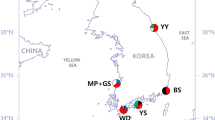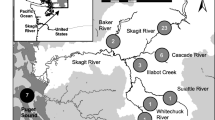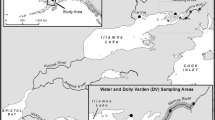Abstract
Dolly Varden (Salvelinus malma) is a facultatively anadromous and iteroparous salmonid species, widely distributed around the Pacific Rim. Its distribution overlaps in northern areas with the circumpolar congeneric Arctic char (S. alpinus), which shares some of its life history traits. Despite the abundance of both species in many Alaskan watersheds and the diversity of their life histories, relatively little is known about their estuarine and marine ecology and migrations. Thirty char, taken as by-catch in the sockeye salmon (Oncorhynchus nerka) gill net fishery in the Egegik District, Bristol Bay, Alaska in June and July 2013, were identified using molecular genetic techniques as Dolly Varden. Otoliths indicated that the fish, ranging from 445 to 560 mm fork length, were from 4 to 9 years old, with a modal age of 6 (40 % of the specimens). Microchemical analysis indicated that all fish had first migrated to sea at ages 2 or 3 (16 and 14 individuals, respectively), migrated annually thereafter to a maximum of eight times, and did not over-winter in marine waters. Moreover, the fish were produced by a mix of anadromous mothers (14 fish) and non-anadromous mothers (11 fish); the maternal origin of the other five fish was uncertain. Despite the fact that the fish were captured in the riverine/estuarine environment of the Egegik River, stable isotope analysis of muscle tissue samples indicated that they had relied on marine prey, and this was supported by the high Sr levels in the otoliths, indicating prior occupancy of marine rather than fresh water for all individuals tested. Together, these analyses reveal extensive use of marine resources by Dolly Varden across a wide range of sizes and ages during regular but brief migrations, and provide new information on this facultatively anadromous, long-lived salmonid.




Similar content being viewed by others
References
Angers B, Bernatchez L, Angers A, Desgroseillers L (1995) Specific microsatellite loci for brook charr reveal strong population subdivision on a microgeographic scale. Can J Fish Aquat Sci 47:177–185
Arai T, Morita K (2005) Evidence of multiple migrations between freshwater and marine habitats of Salvelinus leucomaenis. J Fish Biol 66:888–895
Armstrong RH (1974) Migration of anadromous Dolly Varden (Salvelinus malma) in southeastern Alaska. J Fish Res Board Can 31:435–444
Armstrong RH (1984) Migration of anadromous Dolly Varden charr in southeastern Alaska - a manager’s nightmare. In: Johnson L, Burns B (eds) Biology of the arctic charr: proceedings of the international symposium on arctic charr. University of Manitoba Press, Winnipeg, pp 559–570
Armstrong JB, Bond MH (2013) Phenotype flexibility in wild fish: Dolly Varden regulate assimilative capacity to capitalize on annual pulsed subsidies. J Anim Ecol 82:966–975
Aydin KY (2010) Analysis of fall, winter, and spring predation of key Bering Sea and Gulf of Alaska groundfish through food habits and stable isotope analysis. N Pac Res Board Final Rep 622:202
Behnke RJ (1980) A systematic review of the genus Salvelinus. In: Balon EK (ed) Charrs: Salmonid fishes of the genus Salvelinus. Dr. W. Junk, The Hague, pp 441–480
Bernard DR, Helper KR, Jones JD, Whalen ME, McBride DN (1995) Some tests of the “migration hypothesis” for anadromous Dolly Varden (southern form). Trans Am Fish Soc 124:297–307
Blackett RF (1973) Fecundity of resident and anadromous Dolly Varden (Salvelinus malma) in southeastern Alaska. J Fish Res Board Can 30:543–548
Bond MH (2013) Diversity in migration, habitat use, and growth of Dolly Varden char in Chignik Lakes, Alaska. Ph. D. dissertation, University of Washington, Seattle
Bond MH, Quinn TP (2013) Patterns and influences on Dolly Varden migratory timing in Chignik Lakes, Alaska, and comparison to populations throughout the Northeastern Pacific and Arctic oceans. Can J Fish Aquat Sci 70:655–665
Bond MH, Miller JA, Quinn TP (2015) Beyond dichotomous life histories in partially migrating populations: cessation of anadromy in a long-lived fish. Ecology (in press)
Brenkman SJ, Corbett SC, Volk EC (2007) Use of otolith chemistry and radiotelemetry to determine age-specific migratory patterns of anadromous bull trout in the Hoh River, Washington. Trans Am Fish Soc 136:1–11
Burgner RL (1991) Life history of sockeye salmon (Oncorhynchus nerka). In: Groot C, Margolis L (eds) Pacific salmon life histories. University of British Columbia Press, Vancouver, pp 1–117
Burgner RL, DiCostanzo CJ, Ellis RJ, Harry GY Jr, Hartman WL, Kerns OE Jr, Mathisen OA, Royce WF (1969) Biological studies and estimates of optimum escapements of sockeye salmon in major river systems in Southwestern Alaska. Fish Bull 67:405–459
Campana SE (1999) Chemistry and composition of fish otoliths: pathways, mechanisms and applications. Mar Ecol Progr Ser 188:263–297
Church MR, Ebersole JL, Rensmeyer KM, Couture RB, Barrows FT, Noakes DLG (2009) Mucus: a new tissue fraction for rapid determination of fish diet switching using stable isotope analysis. Can J Fish Aquat Sci 66:1–5
Courter II, Child DB, Hobbs JA, Garrison TM, Glessner JJG, Duery S (2013) Resident rainbow trout produce anadromous offspring in a large interior watershed. Can J Fish Aquat Sci 70:701–710
Crane PA, Lewis CJ, Kretschmer EJ, Miller SJ, Spearman WJ, DeCicco AL, Lisac MJ, Wenburg JK (2004) Characterization and inheritance of seven microsatellite loci from Dolly Varden, Salvelinus malma, and cross-species amplification in Arctic char, S. alpinus. Conserv Genet 5:737–741
Crawford DL (2001) Bristol Bay sockeye salmon smolt studies for 2001. Regional Information Report 2A0127. Alaska Department of Fish and Game, Anchorage
Curry RA, Gautreau MD, Culp JM (2014) Fin tissues as surrogates of white muscle when assessing carbon and nitrogen stable isotope levels for Arctic and brook char. Environ Biol Fish 97:627–633
DeCicco AL (1992) Long-distance movements of anadromous Dolly Varden between Alaska and the U.S.S.R. Arctic 45:120–123
DeLacy AC, Morton WM (1943) Taxonomy and habits of the charrs, Salvelinus malma and Salvelinus alpinus, of the Karluk drainage system. Trans Am Fish Soc 72:79–91
Denton KP, Rich HB Jr, Moore JW, Quinn TP (2010) The utilization of a Pacific salmon Oncorhynchus nerka subsidy by three populations of charr Salvelinus spp. J Fish Biol 77:1006–1023
Dodson JJ, Aubin-Horth N, Thériault V, Páez DJ (2013) The evolutionary ecology of alternative migratory tactics in salmonid fishes. Biol Revs 88:602–625
Doucett RR, Hooper W, Power G (1999) Identification of anadromous and nonanadromous adult brook trout and their progeny in the Tabusintac River, New Brunswick, by means of multiple-stable-isotope analysis. Trans Am Fish Soc 128:278–288
Etheridge EC, Harrod C, Bean C, Adams CE (2008) Continuous variation in the pattern of marine v. freshwater foraging in brown trout Salmo trutta L. from Loch Lomond, Scotland. J Fish Biol 73:44–53
Fry B (2006) Stable isotope ecology. Springer, New York
Furey NB, Hinch SG, Lotto AG, Beauchamp DA (2015) Extensive feeding on sockeye salmon Oncorhynchus nerka smolts by bull trout Salvelinus confluentus during initial outmigration into a small, unregulated, and inland British Columbia river. J Fish Biol 86:392–401. doi:10.1111/jfb.12567
Hayes MC, Rubin SP, Reisenbichler RR, Goetz FA, Jeanes E, McBride A (2011) Marine habitat use by anadromous bull trout from the Skagit River, Washington. Mar Coast Fish 3:394–410
Heady WJ, Moore JW (2013) Tissue turnover and stable isotope clocks to quantify resource shifts in anadromous rainbow trout. Oecologia 172:21–34
Jaecks T, Quinn TQ (2014) Ontogenetic shift to dependence on salmon-derived nutrients in Dolly Varden char from the Iliamna River, Alaska. Environ Biol Fish 97:1323–1333
Jonsson B, Jonsson N (1993) Partial migration: niche shift versus sexual maturation in fishes. Revs Fish Biol Fish 3:348–365
Jonsson B, Jonsson N (2011) Ecology of Atlantic salmon and brown trout: habitat as a template for life histories. Springer, New York
Jonsson B, Skúlason S, Snorrason SS, Sandlund OT, Malmquist HJ, Jónasson PM, Gydemo R, Lindem T (1988) Life history variation of polymorphic Arctic charr (Salvelinus alpinus) in Thingvallavatn, Iceland. Can J Fish Aquat Sci 45:1537–1547
Kalish JM (1990) Use of otolith microchemistry to distinguish the progeny of sympatric anadromous and non-anadromous salmonids. Fish Bull 88:657–666
Kendall NW, Quinn TP (2012) Quantifying and comparing size-selectivity among Alaskan sockeye salmon fisheries. Ecol Appl 22:804–816
Kendall NW, McMillan JR, Sloat MR, Buehrens TW, Quinn TP, Pess GR, Kuzishchin KV, McClure MM, Zabel RW (2015) Anadromy and residency in steelhead and rainbow trout Oncorhynchus mykiss: a review of the processes and patterns. Can J Fish Aquat Sci. doi:10.1139/cjfas-2014-0192
Klemetsen A, Amundsen P-A, Dempson JB, Jonsson B, Jonsson N, O’Connell MF, Mortensen E (2003) Atlantic salmon Salmo salar L., brown trout Salmo trutta L. and Arctic charr Salvelinus alpinus (L.): a review of aspects of their life histories. Ecol Freshw Fish 12:1–59
Kowalchuk MW, Sawatzky CD, Reist JD (2010) A review of the taxonomic structure within Dolly Varden, Salvelinus malma (Walbaum 1792), of North America. Department of Fisheries and Oceans. Can Sci Advis Sec Res Doc 2010/013. Vi + 16 p
Kraus RT, Secor DH (2004) Incorporation of strontium into otoliths of an estuarine fish. J Exp Mar Biol Ecol 302:85–106
Krueger CC, Wilmot RL, Everett RJ (1999) Stock origins of Dolly Varden collected from Beaufort Sea coastal sites of Arctic Alaska and Canada. Trans Am Fish Soc 128:49–57
Lisac MJ (2009) Run timing, seasonal distribution and biological characteristics of Dolly Varden in the Goodnews River, Togiak National Wildlife Refuge, Alaska, 2005–2006. Alaska Fisheries Technical Report Number 103. U.S. Fish and Wildlife Service, Dillingham, Alaska
Lowery ED (2009) Trophic relations and seasonal effects of predation on Pacific salmon by fluvial bull trout in a riverine food web. M.S. thesis, University of Washington, Seattle
Maekawa K, Nakano S (2002) Latitudinal trends in adult body size of Dolly Varden, with special reference to the food availability hypothesis. Pop Ecol 44:17–22
Miller JA, Kent AJR (2009) The determination of maternal run time in juvenile Chinook salmon (Oncorhynchus tshawytscha) based on Sr/Ca and 87Sr/86Sr within otolith cores. Fish Res 75:373–378
Miller JA, Gray A, Merz J (2010) Quantifying the contribution of juvenile migratory phenotypes in a population of Chinook salmon Oncorhynchus tshawytscha. Mar Ecol Prog Ser 408:227–240
Morinville GR, Rasmussen JB (2006) Marine feeding patterns of anadromous brook trout (Salvelinus fontinalis) inhabiting an estuarine river fjord. Can J Fish Aquat Sci 63:2011–2027
Morita K, Morita SH, Fukuwaka MA, Nagasawa T (2009) Offshore Dolly Varden charr (Salvelinus malma) in the North Pacific. Environ Biol Fish 86:451–456
Morita K, Morita SH, Nagasawa T, Kuroki M (2013) Migratory patterns of anadromous white-spotted charr Salvelinus leucomaenis in eastern Hokkaido, Japan: the solution to a mystery? J Ichthyol 53:809–819
Narver DW, Dahlberg ML (1965) Estuarine food of Dolly Varden at Chignik, Alaska. Trans Am Fish Soc 94:405–408
Omelchenko VT, Salmenkova EA, Shedko SV (2002) Allozyme diversity and genetic divergence of the Dolly Varden Salvelinus malma Walbaum from the Kuril Islands. Russ J Genet 38:1066–1075
Parnell AC, Inger R, Bearhop S, Jackson AL (2010) Source partitioning using stable isotopes: coping with too much variation. PLoS One 5:e9672
Pavlov DS, Savvaitova KA (2008) On the problem of ratio of anadromy and residence in salmonids (Salmonidae). J Ichthyol 48:778–791
Phillis CC, Ostrach DJ, Ingram BL, Weber PK (2011) Evaluating otolith Sr/Ca as a tool for reconstructing estuarine habitat use. Can J Fish Aquat Sci 68:360–373
Post DM (2002) Using stable isotopes to estimate trophic position: models, methods, and assumptions. Ecology 83:703–718
Post DM, Layman CA, Arrington DA, Takimoto G, Quattrochi J, Montana CG (2007) Getting to the fat of the matter: models, methods and assumptions for dealing with lipids in stable isotope analyses. Oecologia 152:179–189
Quinn TP (2005) The behavior and ecology of Pacific salmon and trout. University of Washington Press, Seattle
Quinn TP, Myers KW (2004) Anadromy and the marine migrations of Pacific salmon and trout: Rounsefell revisited. Revs Fish Biol Fish 14:421–442
Radtke RL, Svenning M, Malone D, Klemensten A, Ruzicka J, Fey D (1996) Migrations in an extreme northern population of Arctic charr Salvelinus alpinus: insights from otolith microchemistry. Mar Ecol Progr Ser 136:13–23
Randall RG, Healey MC, Dempson JB (1987) Variability in length of freshwater residence of salmon, trout, and char. Am Fish Soc Symp 1:27–41
Reist JD, Johnson JD, Carmichael TJ (1997) Variation and specific identity of char from northwestern Arctic Canada and Alaska. Am Fish Soc Symp 19:250–261
Rinella DJ, Wipfli MS, Stricker CA, Heintz RA, Rinella MJ (2012) Pacific salmon (Oncorhynchus spp.) runs and consumer fitness: growth and energy storage in stream-dwelling salmonids increase with salmon spawner density. Can J Fish Aquat Sci 69:73–84
Riva-Rossi CM, Pascual M, Babaluk JA, Garcia Asorey MI, Halden NM (2007) Intra-population variation in anadromy and reproductive life span in rainbow trout introduced in the Santa Cruz River, Argentina. J Fish Biol 70:1780–1797
Rounsefell GA (1958) Anadromy in North American Salmonidae. Fish Bull 58:171–185
Ruggerone GT, Rogers DE (1984) Arctic char predation on sockeye salmon smolts at Little Togiak River, Alaska. Fish Bull 82:401–410
Salmenkova EA, Omelchenko VT (2014) Genetic divergence and taxonomic status of chars of the genus Salvelinus. Biol Bull Rev 3:481–492
Scanlon B (2000) The ecology of the Arctic Char and the Dolly Varden in the Lake Becharof drainage, Alaska. M. S. Thesis, University of Alaska, Fairbanks
Secor DH, Henderson-Arzapalo A, Piccoli PM (1995) Can otolith microchemistry chart patterns of migration and habitat utilization in anadromous fishes? J Exp Mar Biol Ecol 192:15–33
Tallman RF, Saurette F, Thera T (1996) Migration and life history variation in Arctic charr, Salvelinus alpinus. Ecoscience 3:33–41
Taylor EB, Lowery E, Lilliestråle A, Elz A, Quinn TP (2008) Genetic analysis of sympatric char populations in western Alaska: Arctic char (Salvelinus alpinus) and Dolly Varden (Salvelinus malma) are not two sides of the same coin. J Evol Biol 21:1609–1625
Weir BS, Cockerman CC (1984) Estimating F-statistics for the analysis of population structure. Evolution 38:1358–1370
Acknowledgments
We thank the individual fishermen and Icicle Seafood Company for donating the specimens. Financial support was provided by the H. Mason Keeler Professorship to T. P. Quinn and the School of Aquatic and Fishery Sciences, and by the Natural Sciences and Engineering Research Council of Canada operating and equipment grants to E. B. Taylor, University of British Columbia for the genetic analyses. Andy Ungerer of the Oregon State University W.M. Keck Collaboratory for Plasma Spectrometry assisted with otolith analysis. We also thank J. Ching for help creating the ArcGIS map, and the reviewers for helpful comments.
Author information
Authors and Affiliations
Corresponding author
Rights and permissions
About this article
Cite this article
Hart, L.M., Bond, M.H., May-McNally, S.L. et al. Use of otolith microchemistry and stable isotopes to investigate the ecology and anadromous migrations of Northern Dolly Varden from the Egegik River, Bristol Bay, Alaska. Environ Biol Fish 98, 1633–1643 (2015). https://doi.org/10.1007/s10641-015-0389-1
Received:
Accepted:
Published:
Issue Date:
DOI: https://doi.org/10.1007/s10641-015-0389-1




